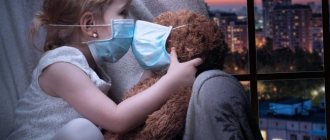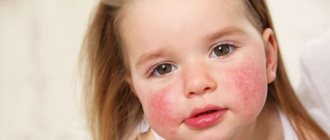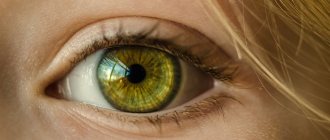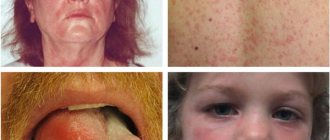A food allergy is a condition where the body reacts to a certain food as if it were a harmful substance. Both children and adults suffer from food allergies. But while a child’s allergy to any product may go away with age, an adult’s allergy, unfortunately, remains.
How do food allergies manifest? What foods to exclude from the menu to prevent an allergic reaction? How to treat food allergies? Let's try to answer these and other questions...
The most common allergens
Products that most often cause food allergies:
- eggs;
- nuts (hazelnuts, almonds, peanuts, etc.);
- fish;
- citrus fruits (oranges, tangerines, etc.);
- berries (strawberries, wild strawberries, etc.);
- chocolate;
- milk;
- legumes (soybeans, beans, peas, etc.).
- nutritional supplements.
Allergens found in some foods may be similar to pollen allergens. This is called cross allergy. For example, wormwood pollen is a cross-allergen for peppers, carrots, mustard, bananas, and citrus fruits. This means that a patient with hay fever may also have food allergies.
Allergy and Enterosgel
In the development of allergies, the key factor is the contact of the allergen (some substance in the air, food, clothing, etc.) with the body. Accordingly, minimizing or eliminating such contact prevents the development of the reaction, which explains the effectiveness of Enterosgel.
It is known that the intestines play a critical role in the functioning of the immune system. Enterosgel removes allergens from the gastrointestinal tract. In addition, Enterosgel removes bacterial endotoxins, promotes the regeneration of damaged mucosa and normalizes the intestinal microflora.
Thus, the functioning of the intestines and immune system is restored, and allergic manifestations are reduced. At the first signs of a possible allergy, you can take Enterosgel in a standard dose. Then use the drug according to the instructions for 1-2 weeks.
Need to know
The body's rapid and violent reaction to a food allergen is called anaphylaxis (anaphylactic shock). As a rule, anaphylaxis manifests itself 1-2 hours after the food allergen enters the body. It causes the tongue and throat to swell, breathing becomes difficult to the point of suffocation, vomiting occurs, blood pressure decreases, and the person loses consciousness. If you suspect anaphylactic shock, call an ambulance immediately!
In recent years, food allergies have become quite common. The most severe allergic reaction occurs to peanuts. Scientists conducted a study in which genes “responsible” for food allergies were found and studied. In 20% of cases it is a peanut allergy!
Rating of the top 10 inexpensive and effective allergy pills according to KP
Each generation of antihistamines includes agents that are widely used in the treatment or prevention of allergic reactions. We talked with experts and selected the most popular, actively used products that can be purchased in pharmacies without a prescription.
Allegra
Allegra. Photo: SANOFI WINTHROP INDUSTRIE
The latest generation anti-allergy drug. The most modern and safe product that works for a long time and effectively. The drug is based on fexofenadine hydrochloride. Selectively affects only H1-histamine receptors, without affecting their other types. The effect occurs quickly and lasts up to a day without side effects (sedative and inhibitory).
Indications for use:
- hay fever;
- year-round allergies;
- hives;
- various forms of dermatitis;
- reactions to insect bites;
- drug and food allergies.
Important! The drug is not used during pregnancy and lactation, in children of early and school age (up to 12 years).
show more
Zodak
Zodak. Photo: Zentiva
A fairly popular remedy against seasonal or year-round allergies. It belongs to the third generation drugs; the drug is based on the active substance – cetirizine. The tablets have pronounced antiallergic properties and block H1-histamine receptors for a long time. The medicine does not provoke side effects typical of first and partially second generation drugs. When taking Zodak there is no drowsiness, lethargy or decreased reaction speed. Also, the drug does not impair visual functions and does not have a negative effect on the functioning of the heart, liver and kidney tissues.
Indications for use:
- year-round or seasonal runny nose, hay fever;
- allergic conjunctivitis, various dermatitis;
- different types of urticaria;
- acute angioedema;
- prevention of food and drug allergies, etc.
Important! The drug is not compatible with alcohol; when taken together, negative effects and inhibitory effects on the nervous system may occur. The drug is eliminated from the body for a long time, so it can be taken only once a day.
show more
Loratadine
Loratadine. Photo: Tatkhimpharmpreparaty
The antihistamine drug belongs to the 2nd generation drugs. Effectively blocks H1-histamine receptors, eliminating swelling, itching and redness. The drug is effective for rhinitis, conjunctivitis and angioedema, and is useful for relieving itching and swelling from stinging and blood-sucking insect bites.
Indications for use:
- various forms of allergic rhinitis (both seasonal and year-round forms); hay fever;
- different forms of urticaria;
- dermatoses with skin itching, redness and swelling;
- adjuvant in the treatment of bronchial asthma,
- pseudoallergic reaction.
Important! The drug has some sedative effect, so when taking it, it is not advisable to drive a car or practice various activities that require high concentration.
show more
Kestin
Kestin. Photo: Almirall
An antihistamine of the latest generation, available in the form of instant and regular tablets. The speed of onset of the effect depends on the form of release. The main active ingredient is ebastine, a histamine H1 receptor blocker.
The drug has an antihistamine, antiallergic effect, eliminates swelling, itching and redness of the skin and mucous membranes. After oral administration, it begins to work within an hour and the effect lasts up to 48 hours. It does not have a sedative or hypnotic effect, and does not cause dryness of the mouth and mucous membranes.
Indications for use:
- various types of allergic rhinitis (hay fever, year-round rhinitis);
- food and drug allergies, reactions to household dust, animals;
- urticaria, which is caused by various allergens;
- drug allergy.
Important! The drug is not used in children under 12 years of age, during pregnancy and breastfeeding. The medicine is incompatible with alcohol.
show more
Tsetrin
Cetrin. Photo: Dr. Reddy's
One of the most popular drugs for seasonal and year-round allergies. It belongs to the third generation drugs, the main active ingredient is cetirizine. It has a pronounced antiallergic effect, blocks H1-histamine receptors, but does not cause side effects typical of the first and partially second generation: drowsiness, inhibition of reflexes and reaction speed. Also, the drug does not impair the functions of the visual analyzer and does not have a negative effect on the functioning of the heart, liver tissue and kidneys.
Indications for use:
- year-round or seasonal runny nose, hay fever;
- allergic conjunctivitis, dermatitis;
- different forms of urticaria;
- Quincke's edema;
- prevention of food and drug allergies, etc.
Important! The drug is not compatible with alcohol; when taken together, negative effects and inhibitory effects on the nervous system may occur. The drug is eliminated from the body for a long time, so it can be taken once a day.
show more
Erius
Erius. Photo: Schering-Plough Labo NV
The drug is in tablets and syrup. It is of the third generation with the active substance – desloratadine. It has a long-lasting antihistamine and anti-inflammatory effect and can be used for the treatment and prevention of allergic reactions. It has an antipruritic and anti-edematous effect, does not affect the nervous system and heart muscle, and does not overload the kidneys. The effect of the medicine begins in 30 - 40 minutes and lasts more than a day.
Indications:
- allergic rhinitis, hay fever, conjunctivitis;
- food allergies, reactions to medications;
- elimination of various forms of allergic dermatoses with swelling and itching;
- prevention of seasonal exacerbations of allergies.
Important! Although the drug does not enhance the negative effects of alcohol on the body, you should not drink alcohol during treatment. This can affect the functioning of the kidneys and liver.
show more
Zyrtec
Zyrtec. Photo: UCB Pharma, SA
The tablets contain the active ingredient – cetirizine. They belong to the second generation of drugs, have a long-lasting effect and have virtually no sedative effects.
When taken orally, it begins to act within an hour, the effect lasts up to 24 hours or more. It has a decongestant and antipruritic effect, suppresses the release of histamine during allergic reactions, and can be used for preventive purposes during the hay fever season. It has a relatively small list of side effects and contraindications and is used in children (in the form of drops) and adults.
Indications:
- seasonal and year-round conjunctivitis, rhinitis, pharyngitis;
- food and drug allergies;
- various skin reactions with itching and swelling, redness;
- as one of the components in the treatment of itchy dermatoses and atopic dermatitis;
- prevention of seasonal hay fever.
Important! If you have kidney problems, you should take it only after consulting a doctor; it is incompatible with alcohol; the toxic effect on the kidneys may increase.
Claritin
Claritin. Photo: Schering-Plough Labo NV
Available in the form of tablets and syrup, the active ingredient is loratadine. Second generation drug. When taken orally, it begins to work quite quickly, after 30 - 40 minutes, and the effect lasts up to 24 hours. It does not have an inhibitory effect on the nervous system, so it can be used by drivers and people who need extreme concentration. Can effectively suppress allergic reactions in the skin, respiratory tract and digestive system. However, with very long-term use it can affect kidney function, so treatment should be monitored by a doctor. Indications:
- acute allergic reactions to food, medications, household allergens;
- seasonal hay fever and year-round rhinitis, accompanied by severe swelling and itching of the mucous membranes, lacrimation, and runny nose;
- urticaria of various origins;
- allergic skin rashes with itching and redness.
Important! It can be used in children in the form of syrup, but it is important to monitor blood and urine tests, for example, in pregnant women according to strict indications. It is forbidden to take the drug together with alcohol; it may have sedative and toxic effects, including on the kidneys.
show more
Tavegil
Tavegil. Photo: FAMAR ITALIA, SpA
The drug in tablets is sold in pharmacies without a prescription; the active ingredient is clemastine. It belongs to the first generation of drugs, but unlike many others, it has a fairly long period of action - up to 8 - 12 hours. It is used to suppress acute allergic reactions with severe redness of the skin, swelling of the mucous membranes, itching and general malaise. It is used in the complex treatment of anaphylactic reactions (the solution is administered intramuscularly or intravenously).
Indications:
- acute allergic reactions to the skin with swelling and itching (contact dermatitis, reactions to food, medications);
- acute respiratory allergies (hay fever, year-round rhinitis);
- allergic conjunctivitis with itching, burning of the eyes and lacrimation;
- food allergies;
- atopic dermatitis and eczema (as a component of combination treatment).
Important! The drug has a pronounced sedative and antispasmodic effect, is prohibited when driving a car, and combined use with alcohol is unacceptable. The medicine should be used very carefully together with blood pressure medications and MAO inhibitors (antidepressants).
show more
Suprastin
Suprastin. Photo: Egis
The drug in tablets is available in any pharmacy and belongs to the first generation drugs. The main active ingredient is chloropyramine. It has a fairly pronounced antihistamine effect, the effect when taken in tablets occurs within 20 - 30 minutes, reaching a maximum by the end of the first hour. On average, the medicine works for up to 4 - 6 hours. In addition to the main effect, it affects blood vessels and smooth muscles, reducing swelling and skin itching, inhibits the action of the central nervous system (CNS), creating a sedative and mild hypnotic, calming effect. For acute allergies with itching and irritability, this is a useful action, but driving a car or engaging in activities that require concentration while taking Suprastin is prohibited. It also enhances the sedative, inhibitory effect of alcohol.
Indications:
- acute allergic reactions on the skin with rash and itching, including when taking medications;
- allergic rhinitis, both seasonal (hay fever) and year-round (reactions to dust, wool, mold);
- reactions to insect bites (including as a component of emergency care for anaphylaxis to the venoms of stinging insects, administered intramuscularly or intravenously);
- food allergies;
- various forms of atopic dermatitis and eczema.
Important! The medicine is not used for prophylactic purposes, it has side effects, the course of treatment should not last more than 5 - 10 days.
show more
What a hello, what a response
An allergic response to any food component depends on our immune system and hereditary predisposition. Immune cells produce antibodies in response to the introduction of an allergen into the body.
The reasons for the development of allergies may be associated with the action of negative factors (for example, air pollution from exhaust gases or industrial waste). Food allergies to certain foods can be a consequence of problems in early childhood. For example, early refusal of breastfeeding, improper introduction of complementary foods, feeding with foods containing excess dyes, preservatives and other “chemicals”. It’s even worse if a breastfeeding mother does not keep a food diary - in this case, it is much more difficult to figure out what exactly caused the child’s allergies. As a result, the child develops diathesis - allergies on the face, skin of the neck, and limbs.
Interesting fact
After many years of observations, Japanese pediatricians found that first-born children suffer from allergies more often than younger children. Unfortunately, there is no scientific explanation for this phenomenon yet.
Most immunologists are confident that allergies are an “erroneous” reaction of the body to substances that are harmless to other people. Some adhere to a radically opposite theory, arguing that it is allergies that protect the body from foreign substances, for example, xenobiotics. According to this theory, in the process of evolution, allergic reactions developed in response to the emergence of a large number of new substances in the world around us. Perhaps, in this way, if you are allergic to plant pollen, the body warns its owner about their toxicity?
From this position, allergic reactions even benefit the body - a person avoids contact with allergens in the future and reduces their harmful effects on health. Do not forget that the line between benefit and harm is sometimes very thin. By consuming substances that are harmful to yourself and thus provoking signs of food allergies, you can bring the body into anaphylactic shock!
However…
British scientists have found that for 20% of their compatriots, food allergies are just a fiction that justifies laziness, excess weight, rashes on the body, and reluctance to eat right or exercise. In fact, only 2% of them have a food allergy (ICD 10 code - T78.1).
Symptoms of different types of allergies
08.10.2021
A person who has been suffering from this disease for a long time can easily identify the first signs of an allergy . But if the disease began recently, you should learn to distinguish allergic symptoms from other painful manifestations. Additionally, the symptoms listed may identify the product or substance that is causing the immune .
Symptoms of allergies to cat and dog hair
Symptoms allergies include hives and redness. In addition to reactions to pet dander, allergens are also found in the animal's saliva, urine , and dead epidermal cells. Therefore, symptoms of the disease may also appear at the site of a bite or scratch.
- prolonged dry cough
- breathing vibration occurs when you take a deep breath
- hoarseness of voice
- nasal congestion , runny nose , rhinitis
- nasal discharge
- eye irritation
- lacrimation
Allergy to cold and its symptoms
allergy symptoms become stronger with constant contact with cold water or being outside in winter, then talking about cold allergy It should be borne in mind that an allergy to cold is not an independent disease, but signals serious disorders of the immune or endocrine systems. The following symptoms may indicate an allergy to cold:
- swelling of exposed parts of the body (arms, face , neck )
- redness and itching of the skin
- dry and flaky skin
- pink rash on face and chest
- burning of the skin of exposed areas of the body
- headache
- lowering blood pressure
- difficulty breathing
- sore throat , itching in the nose , ears .
Allergy to dust or household chemicals
This type of allergy affects most young children and adults who have a hereditary tendency to allergic diseases, as well as people suffering from a chronic form of this disease. For such people, any speck of dust or any particle of any chemical substance will be perceived by the immune system as an allergen and symptoms will appear, such as:
- allergic rhinitis , sneezing
- purulent conjunctivitis
- asthma , difficulty breathing
- nasal discharge
- scabies and burning sensation in the nose and throat
- headache, lacrimation
- redness of the whites of the eyes , blurred vision
- inflammatory processes of the respiratory tract
This type of allergy can also be caused by household mites and their waste products, as well as dead cells of their epidermis.
Food allergy and its symptoms
A food allergy is an excessively expressed immune response of the body to food components, usually proteins. Symptoms of an allergic reaction can range from mild to severe. A reaction to any food component appears immediately after eating food and lasts for several minutes or hours. Mild symptoms go away on their own and do not appear if you abstain from certain foods that may contain the same component that caused the allergy . anaphylactic shock can occur , which is life-threatening. of food allergies can be identified .
- itching and burning in the mouth and lips
- intestinal spasms , diarrhea , nausea , vomiting
- urticaria , eczema , dermatitis , diathesis
- Quincke's edema , anaphylactic shock
- fever
To avoid allergy and prevent recurrence, a series of examinations should be carried out to help identify allergens and eliminate foods containing them from the diet. You can relieve symptoms with antihistamines. People prone to allergies can also become victims of drug allergies A drug allergic reaction develops only after repeated administration (contact) of drugs.
Symptoms of drug allergies
- redness of the skin, rashes of various types
- itchy skin, urticaria
- Quincke's edema , asthma , anaphylactic shock
- runny nose , conjunctivitis
- severe decrease in blood pressure
- shortness of breath, pulmonary edema
- gastrointestinal disorders
- liver and kidney damage
- heartache _
- headaches, migraines.
You can also identify an allergy to alcohol, the symptoms of which should be known to all adults. The sudden appearance of red spots on the face and neck , surges in blood pressure, paroxysmal pain in the stomach , vomiting, paroxysmal headaches and instant intoxication may indicate an allergic reaction of alcohol to the body. You need to pay attention to these symptoms if this happens for the first time, and the symptoms appeared after drinking alcohol for the first time while sober.
Published in Allergology Premium Clinic
Types of food allergies
Based on time and nature, the following forms of manifestation of food allergies are distinguished:
- Sudden - when consuming a product that has not previously caused an allergic reaction, numbness in the mouth, allergies on the face (in the form of redness of the skin), nasal congestion, swelling of the tongue suddenly appear;
- Persistent food allergies in adults, the symptoms and treatment of which we will consider a little later. This reaction occurs constantly in response to the consumption of prohibited foods and, if the diet is not followed, requires regular therapy;
- Hidden - the reaction does not occur immediately, but as antibodies accumulate to certain allergens.
- Severe food allergies. Symptoms occur immediately in response to the consumption of an allergen product.
Drug allergy
The article was checked by general practitioner Lisina M.S. , is for general informational purposes only and does not replace specialist advice. For recommendations on diagnosis and treatment, consultation with a doctor is necessary.
Doctors at the Allergology Department of the Yauza Clinical Hospital have extensive experience in the diagnosis and treatment of drug allergies and develop individual monitoring programs for each patient.
Few of us can do without medications: from time to time we all have to take them to cure acute respiratory viral infections, acute respiratory infections, or cope with a chronic disease. And more and more effective drugs are appearing on the market. Unfortunately, drug allergies can become an obstacle to effective treatment.
Drug allergies often occur when taking drugs independently and uncontrolled. That is why it is necessary to seek help from a specialist both to prescribe medications and to correctly determine drug allergies.
Symptoms of drug allergies
Drug allergies are characterized by a sudden onset in the form of an attack. It can develop acutely, within an hour after taking the drug, on the first day after taking it (subacute type reaction) and within several days (prolonged type reaction).
The main manifestations of drug allergies include the following:
- hives, rash;
- redness of the eyes and skin;
- labored breathing;
- itching and burning;
- anaphylactic shock;
- Quincke's edema.
In some cases, fever or joint pain occurs in response to medications. These symptoms are not related to the underlying disease.
The difficulty in diagnosing drug allergies is that different people have different reactions to the same drug. Thus, it is very difficult to systematize the symptoms and quickly determine which drug the reaction occurred to (if the patient is taking several medications).
Causes and pathogenesis of drug allergies
Medicines can cause allergies on their own (for example, if the patient is hypersensitive to one or another component of the medicine), or they can sensitize the body. It is especially important to remember this if you are taking a drug without the consent of your doctor: even nasal drops can be a “trigger” for the development of an allergy to medications.
Often, conditions that are associated with side effects of drugs, occur after discontinuation of the drug (the patient's condition may worsen) or during an overdose are mistaken for hypersensitivity (allergy to a drug).
There are a number of drugs that are more likely to cause allergic reactions than others. These include:
- anesthetics;
- analgesics;
- sedatives;
- antibiotics and sulfonamides;
- anti-inflammatory drugs;
- insulin;
- vaccines, serums.
Since drug allergies can develop very quickly and have serious consequences (anaphylactic shock, Quincke's edema), it is necessary to consult a doctor about this problem and undergo a full examination.
Diagnosis and treatment of drug allergies at the Yauza Clinical Hospital
If symptoms of a drug allergy appear, you should consult a doctor to determine whether it is indeed a reaction to the drug and which one. An allergist at the Yauza Clinical Hospital, together with a dermatologist and therapist, conducts an examination and prescribes the necessary tests and tests. All of them are performed under the supervision of a specialist.
The patient is taken off the medications and prescribed a diet from which, if possible, all allergens are excluded. Alternative therapy is selected to treat the underlying disease. If necessary, the patient undergoes hemocorrection to completely remove the allergen from the body.
Cost of services
You can see prices for services
Risk factors for food allergies in adults
Allergy symptoms and treatment depend on factors such as:
- nature of the allergen;
- age of the person at first contact with the allergen;
- other allergic reactions (eg, hay fever, contact allergy);
- diseases of the digestive system;
- type of contact with the allergen (first or repeated);
- state of intestinal microflora.
Hidden danger
If you are allergic to fish, never lick postage stamps when sending mail! The fact is that the reverse side of the stamp is covered with glue, which is made from fish bones. They licked it, stuck it on, and please - food allergies, allergies on the face, torso, limbs.
A few words about our smaller brothers
It turns out that animals also suffer from food allergens. For example, food allergies in cats occur regardless of gender, breed and age. The main signs are itchy skin, hair loss, scratching on the skin.
Most often, food allergies in cats occur to soy, gluten, seafood, beef, dairy products, and lamb.
In its manifestations, food allergies in purebred dogs are no different from food allergies in dogs – “ mongrels”:
- itching, pimples on the scalp, abdomen, paws;
- discharge from the eyes, nose, ears.
But let's go back to the representatives of the species Homo Sapiens, or, more simply, to people.
What are the symptoms of food allergies in adults?
More often, an immediate response from the body occurs immediately after consuming the allergen product. Sometimes (although less frequently) symptoms appear after several hours or days.
What does a food allergy look like:
- numbness and swelling of the tongue, lips and oral mucosa;
- itching of the skin and oral mucosa;
- difficulty swallowing;
- acne on the skin;
- clear nasal discharge;
- nausea, vomiting;
- allergy on the face in the form of redness;
- sneezing, dry cough;
- colic in the stomach,
- diarrhea (diarrhea).
What factors determine food allergies in adults? Symptoms and treatment of the disease depend on concomitant diseases. For example, scientists have proven a direct connection between food allergies and... diabetes. It turns out that food allergies provoke inflammation in the pancreas and tissue resistance to insulin.
Somatic triggers of itching
Generalized itching that occurs without accompanying manifestations on the skin can be due to various reasons - from skin xerosis to endocrinological pathologies or carcinoma. That is why in clinical practice the assessment of this important prognostic symptom should not be neglected.
Relatively benign etiological factors include drug allergic reactions, dry skin, scabies and primary dermatological diseases. Most often, itchy skin occurs with dry skin. In older patients it is observed in 10-50% of cases [1]. Generalized itching occurs in 13% of patients with chronic renal failure and in 70-90% of those on hemodialysis [2]. Liver diseases accompanied by cholestasis (primary biliary cirrhosis, cholestasis caused by oral contraceptives, intrahepatic cholestasis during pregnancy, etc.) also often cause skin itching [2].
Hematological diseases that cause itching include polycythemia, iron deficiency anemia, endocrine diseases - thyrotoxicosis and diabetes mellitus [3].
Itching is a common clinical manifestation of AIDS and associated Kaposi's sarcoma and opportunistic infections. Thus, itching with or without skin rashes is observed in 84% of patients with AIDS, and in 35.5% of patients with Kaposi's sarcoma that developed against the background of AIDS. AIDS-associated opportunistic infections are accompanied by itching in 100% of cases [4].
It has been established that itchy skin can occur with malignant diseases. For example, with Hodgkin's lymphoma, itching is observed in 10-25% of patients, characterized by high intensity and limited localization, often on the lower legs. In some cases, this symptom precedes the diagnosis of lymphoma and may indicate a less favorable prognosis of the disease than fever or weight loss [4]. Adenocarcinomas and squamous cell cancer of various organs (stomach, pancreas, lungs, colon, brain, breast, prostate) are accompanied by itching in larger areas of the skin: on the legs, upper torso and extensor surfaces of the upper extremities. In this case, there is a direct relationship between the presence of itching and the activity/recurrence of cancer [4].
Secondary itching of the skin is usually associated with taking medications such as opium derivatives (cocaine, morphine, butorphanol), phenothiazines, tolbutamide, erythromycin, anabolic hormones, estrogens, progestins, testosterone, aspirin, quinidine and other antimalarial drugs, biological products ( monoclonal antibodies), vitamin B. In addition, it is known that itching can be a subclinical manifestation of hypersensitivity to any drug [5].
Since itching is observed not only in dermatological pathologies, it is advisable to conduct a thorough examination of the patient (Fig. 1) and treat patients taking into account the identified pathology.
Rice. 1. Algorithm for diagnosing skin itching
What about the children?
Food allergies in a child are a serious problem. Therefore, the main task of parents is to quickly identify the product that causes the allergy and exclude it from the baby’s diet. Food allergies in infants, like food allergies in children 2 years of age and older, are manifested by various rashes: nodules, blisters, pink or red spots. The allergy is located on the face, neck, skin of the extensor surfaces of the joints, torso, buttocks, and itchy skin. The baby eats poorly, sleeps poorly, becomes capricious and restless.
By the way, the statement that a child may be allergic to mother’s milk is nothing more than a myth! Most likely, the baby’s body reacts to allergens that enter the mother’s milk along with food: perhaps the mother ate an egg, fish, chocolate or peanuts the day before...
Various congenital diseases associated with metabolic disorders, for example, phenylketonuria, can also disguise themselves as symptoms of food allergies in children. With such diseases, the body is not able to absorb certain substances - proteins, carbohydrates, etc. The diagnosis can be made through a series of biochemical and genetic studies.
Causes of itchy skin
Itching of the scalp
Caused by diseases of the hair and scalp. It is accompanied by a feeling of skin tightness, scaly desquamation of the epidermis (dandruff), increased oiliness of the hair, excess sebum production, fragility, and sometimes hair loss. Itchy scalp can be caused by incorrectly selected care and styling products (shampoo, conditioner, hairspray). The most common pathological causes of itchy scalp include:
- pathology of the sebaceous glands: dandruff, seborrhea (oily, dry, mixed);
- parasitic diseases: head lice, demodicosis, flea bites, bedbugs;
- mycoses: favus, trichophytosis, microsporia;
- hair shaft abnormalities: idiopathic trichoclasia, knotty hair;
- autoimmune pathologies: psoriasis, SLE, scleroderma;
- other dermatoses: pityriasis versicolor pilaris (Devergie's disease), allergic dermatitis of the scalp;
- general diseases: hypovitaminosis A, heavy metal intoxication, hypothyroidism.
Itchy skin
Body itching
The causes of skin itching can be dermatological and systemic diseases. In some cases, body itching is caused by simple lack of personal hygiene: rarely taking a bath or shower, wearing dirty clothes. On the other hand, itchy skin can occur with infectious and parasitic dermatoses that are contagious to others. Itchy dermatoses are often found in older people (senile itching) and pregnant women. Dermatological diseases that most often cause itchy skin include:
- inflammatory lesions: prickly heat, seborrheic dermatitis, eczema, lichen planus, acne;
- skin infections: herpes, pyoderma, folliculitis, dermatophytosis;
- acariases and entomosis: scabies, demodicosis, pediculosis, insect allergy;
- chronic autoimmune dermatoses: psoriasis, dermatomyositis, Dühring's dermatitis herpetiformis, pemphigoid, pemphigus vulgaris;
- allergic dermatoses: urticaria, prurigo, allergic contact dermatitis, neurodermatitis;
- genodermatoses: ichthyosis, Darier's disease, Haley-Hailey disease;
- skin tumors: leukemides, Sezary syndrome, mycosis fungoides and other T-cell lymphomas of the skin.
Itching of the whole body can be a side effect of taking certain drugs: ACE inhibitors, anti-gout, antiarrhythmics, hormonal drugs, opioids. Systemic diseases occurring with chronic skin itching:
- endocrinopathies: diabetes, hypothyroidism, thyrotoxicosis;
- diseases of the hepatobiliary system and kidneys: cholestasis, cirrhosis of the liver, chronic hepatitis, chronic renal failure;
- infections: HIV, helminthiasis;
- hematological diseases: mastocytosis, leukemia, polycythemia, myeloma, lymphogranulomatosis;
- mental disorders: OCD, depression, dermatozoal delirium.
Itching in the eye area
My eyelids can itch due to any of the listed skin, infectious and general somatic pathologies. However, more often the causes of itching in the eyes are ophthalmological diseases and visual strain. People who use contact lenses, work in contact with dust and chemicals without proper eye protection, and patients with allergies and immunodeficiencies are at risk of developing such a problem. Causes of itchy eyes:
- injuries: foreign bodies, burns, mechanical damage;
- inflammatory diseases: blepharitis, conjunctivitis, meibomitis, barley, keratitis;
- parasitic lesions: demodicosis, dirofilariasis;
- allergies: eyelid dermatitis, hay fever;
- other eye diseases: dry eye syndrome, computer vision syndrome, glaucoma, cataracts.
Food allergies: diagnosis
The diagnosis of “food allergy” is made by a doctor based on a survey of the patient or his relatives (the connection between the symptoms of food allergy and the consumption of a certain product), examination and laboratory test data.
Skin tests are performed. A small amount of liquid that contains the allergen is applied to the skin, after which a small injection or incision is made. If the skin swells at the injection site, like after a mosquito bite, this indicates an allergic reaction, and the size of the rash indicates the strength of the reaction. In addition, immunological tests for food allergies and special tests are carried out.
How to cure food allergies?
Treatment of food allergies is aimed at reducing the symptoms of an allergic reaction, removing the allergen from the body and restoring the intestinal microflora. Accelerates the elimination of toxic products of an allergic reaction by taking sorbents - most often this is the familiar Enterosgel.
In addition, antihistamines are prescribed, and in severe allergies, glucocorticoid hormones.
After identifying the cause of the allergy, a strict hypoallergenic diet is prescribed.
A diet for food allergies involves a complete rejection of foods containing the allergen, as well as smoked foods, marinades and alcoholic beverages. The products are consumed boiled or stewed. What then can a child and an adult do? Casseroles, vegetable soups, cereals, unsweetened tea, crackers, herbal infusions.
This is interesting
Did you know that allergies are afraid of fermented milk products? According to Thai scientists, the best prevention of allergies is a glass of kefir once a day.
- Enterosgel sorbent helps well against allergies: as mentioned above, the drug safely binds and removes allergens, toxins and other harmful compounds from the body, thanks to its unique form, without affecting beneficial substances and microelements;
- For adults, pills for food allergies are selected by the attending physician, taking into account symptoms, concomitant diseases and the form of allergy, so you should not self-medicate. Long-acting antihistamines are considered effective drugs;
- Probiotic preparations protect the intestines and restore microflora;
- For severe forms of food allergies, for example, angioedema, hormonal medications are prescribed.
How to choose allergy pills
Naturally, your doctor should select a specific drug based on what type of allergy you have, how severe and widespread it is, and what effects you want to achieve. Plus, the specialist will definitely take into account all contraindications and possible combinations with other medications you are taking.
But if there is a need to choose allergy pills in order to reduce symptoms and improve the condition as soon as possible, you can focus on certain data. First of all, what generation does the drug belong to? According to WHO, antihistamines are divided into three generations, depending on the level of activity, side effects and safety profile, and the possibility of long-term use.
With the development of pharmacology, the positive properties regarding allergies increased, the time of exposure to the active substance was extended, the number of side effects was reduced, addiction and the list of contraindications were reduced. However, this does not mean that the first generation is bad medicine. Today, drugs of all generations are used, depending on the situation and human needs.
Treatment of food allergies in adults with folk remedies
To reduce signs of an allergic reaction, decoctions of medicinal herbs are suitable: chamomile, nettle, calendula. Baths with string, chamomile, and oat decoction will help relieve skin itching.
Specific immunotherapy offers effective treatment for food allergies in adults: the method is based on the regular administration of small doses of the allergen in order to reduce susceptibility to this substance. On average, treatment lasts from three to five years, but after the course of treatment the body stops reacting violently to the irritant, and the person gets rid of allergies.
Treatment of food allergies in children
Go to any forum dedicated to food allergies - there is always a lively discussion of the symptoms of food allergies in children, methods of treatment and prevention... But what do doctors say?
Strict adherence to the diet and proper care of the child will allow you to forget what food allergies are. Komarovsky believes that the first step is to get rid of allergens that have entered the blood, ensure regular bowel movements and remove allergens. Enterosgel effectively prevents the absorption of “harmful substances” and removes them from the body. In addition, the doctor does not recommend overloading the child with food.
Treatment
Therapeutic treatment methods should be aimed primarily at eliminating pathogenetic factors.
Patients are shown sedatives (especially with intense chronic itching), emollients (to reduce dry skin, which is both a cause and a consequence of itching), topical distraction agents (cold lotions, menthol-containing products, etc.), antihistamines, which In the vast majority of cases, they are first-line drugs.
There are two generations of antihistamines: sedative (Suprastin, Tavegil, Diazolin, Diphenhydramine, Fenkarol, Fenistil) and non-sedating/weak sedative (cetirizine, levocetirizine, loratadine, desloratadine, fexofenadine, ebastine, rupatadine).
It is important to note that, despite the need to take sedatives, it is better not to use first-generation antihistamines (which have a sedative effect in addition to antihistamines). Firstly, sleep when using them is unphysiological (the drugs inhibit the REM sleep phase). Secondly, the multiple side effects characteristic of this group of drugs limit their use in a large group of patients with concomitant diseases. Therefore, it is better to use tranquilizers as sedatives, and when choosing antihistamines, preference should be given to second-generation blockers.
Cetirizine occupies a special place among them.
Prevention
The patient’s main task is to completely eliminate dangerous foods from his menu! With this reasonable approach, the risk of nutritional (food) allergies will be minimized.
Doctors recommend keeping a food diary, which makes it easier to detect the “enemy.” In it, parents should write down everything that their child eats during the day, or everything that the nursing mother ate. Along with the food, the baby’s condition is noted in the diary.
A big mistake would be to refuse breastfeeding due to a nutritional allergy in a child - after all, the unique properties of mother's milk will allow you to quickly cope with the problem. But a nursing mother must adhere to a strict diet, avoiding foods from the “allergenic list.”
In addition, it would be useful to strengthen the immune system, prevent dysbiosis, and timely treatment of exacerbations of chronic diseases or acute viral infections.
Do not forget that food allergies often originate in childhood. For example, a food allergy in a 2-year-old child may eventually manifest itself in adulthood as Quincke's edema.
Alcoholic beverages aggravate food allergy symptoms in adults, so it is advisable to avoid alcohol.
It is important to know!
- Thanks to comprehensive treatment of food allergies, rapid recovery occurs;
- in the future, the patient should avoid foods that cause an allergic reaction;
- if your child has a food allergy, be sure to notify the preschool or school staff about this, and, if possible, document this fact;
- make sure your child wears a special allergy bracelet;
- If your child has previously had an acute allergic reaction, you should always have a first aid kit with an antihistamine and epinephrine (adrenaline). At the first sign of an acute reaction, it is necessary to give the child these medications and call an ambulance.
Be healthy!








